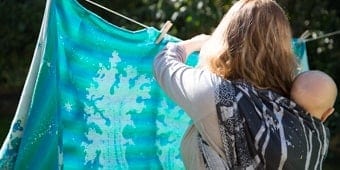(we’re still building this resource for you, so check back for more links soon if you can’t find what you’re looking for, or ask us questions directly at contact@firespiralslings.co.uk!)
Our woven wraps are made from very high quality fibres and they will last a long time given proper care, so that their lifespan will allow them to carry multiple children from birth through to toddlerhood . Their construction is incredibly simple, with no seams, joins or parts that could break. Most of what we consider ‘mending’ (fixing pulls, broken threads) is actually only sorting out small cosmetic issues with the wrap surface, and nothing to do with the safety of the wrap for use.
There are two main considerations to prolong the lifespan of your wrap:
- Washing, drying and ironing your wrap.
- Mending the surface of the cloth if any threads get damaged or moved out of place.
This page contains links to all the information you might need to care for, maintain and mend your woven wraps!

Washing, Drying and Ironing Your Wrap
All of our wraps are pretty simple to care for on a daily basis, and they only need washing when they first arrive with you, then any time that they get dirty. They are designed to withstand the vigorous use of carrying small children, and all the stickiness and mess that they can bring with them!
- Here’s a general overview of a woven wrap, and what you should expect to find on your wrap.
- When your brand new wrap arrives, it will be in loomstate. You will need to wash and dry it before first use.
- The black mesh bag that your wrap arrives in is a delicates laundry bag and can be used to wash your wrap in.
- General washing instructions for our all cotton wraps, and any other blends unless specified. This includes extra advice for crease prone wraps
- Washing instructions for wraps with a wool content. Some very low percentage wool wraps can be washed in the same way as the non-wool blends.
Caring For Your Wrap
There are lots of ways to safely store your wrap when not in use. If you don’t plan to use it for while, then running an iron over your wrap before you fold it and put it away will help to deter fold creases. Store out of direct sunlight if your wraps could be sitting in the same position on a shelf for weeks at a time.
Braiding your wrap is a handy way to store and transport it for short periods of time
It might sound simple, but measuring your wrap accurately can be a bit tricky, given that cloth has stretch and wraps are so long! To get an accurate measurement need to get the right balance of creating natural tension in the cloth without overstretching it. A freshly washed wrap will also measure shorter at first, until the cloth relaxes back into its natural state.
You might also want to work out the GSM (weight per square metre in grams) of your wrap. This guide shows you how, and also discusses why GSM should only be considered in the context of other factors when choosing a wrap.
Fixing Your Wrap
Pulls
Perhaps the most common issue that people want to fix on wraps is a pull. This is a single thread (usually a warp thread) that has literally been pulled out of the cloth a little way and created a loop on the surface of the cloth. It isn’t unsafe, you can leave it alone and do nothing to it, and realistically you will probably never spot it in use. If you do want to fix a pull then there are several ways to do so.
Small pulls- literally tiny nubs of yarn can be worked back into place with a needle.
Fixing a longer pull is most easily and invisibly done by snipping the loop into two, then weaving back into the cloth.